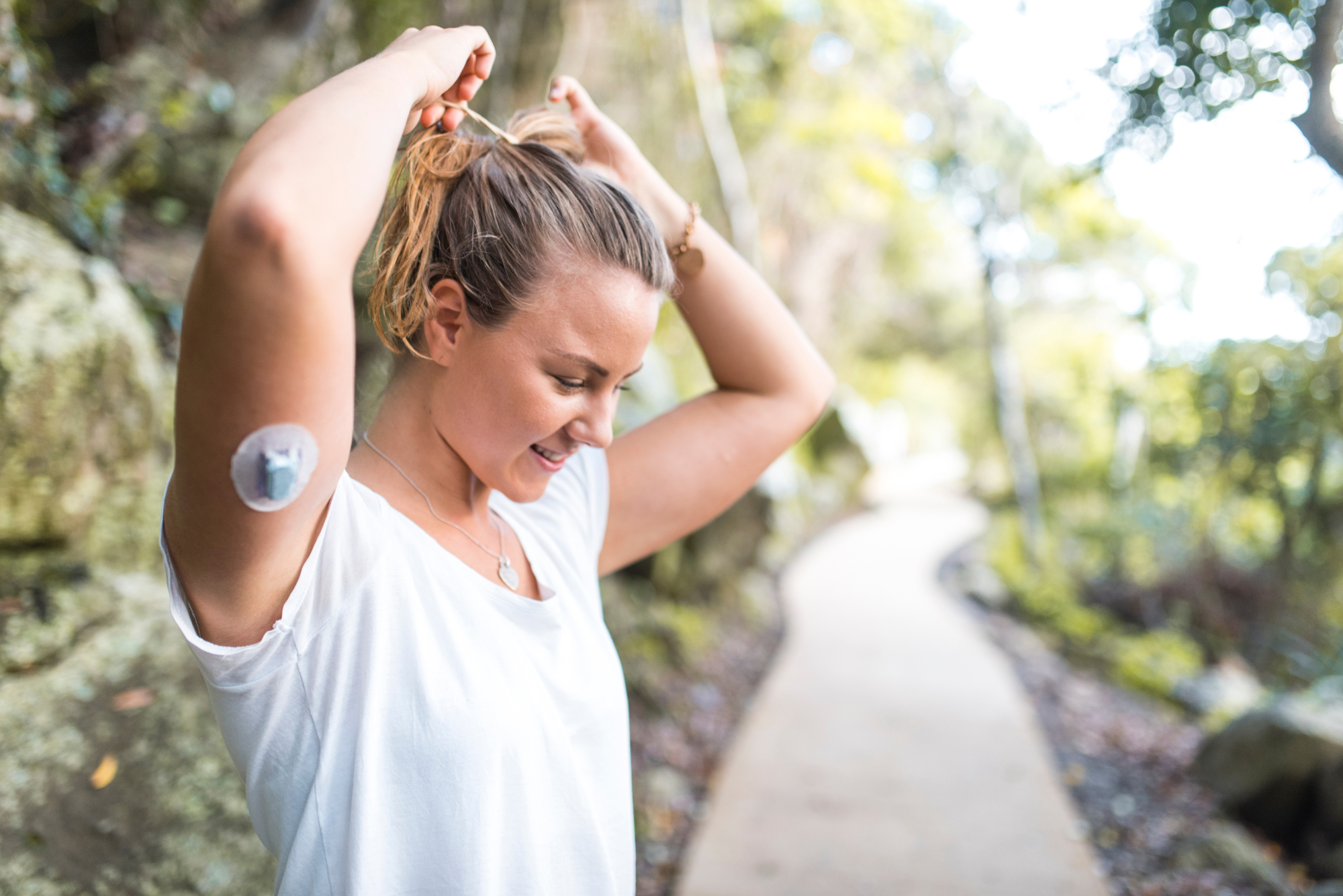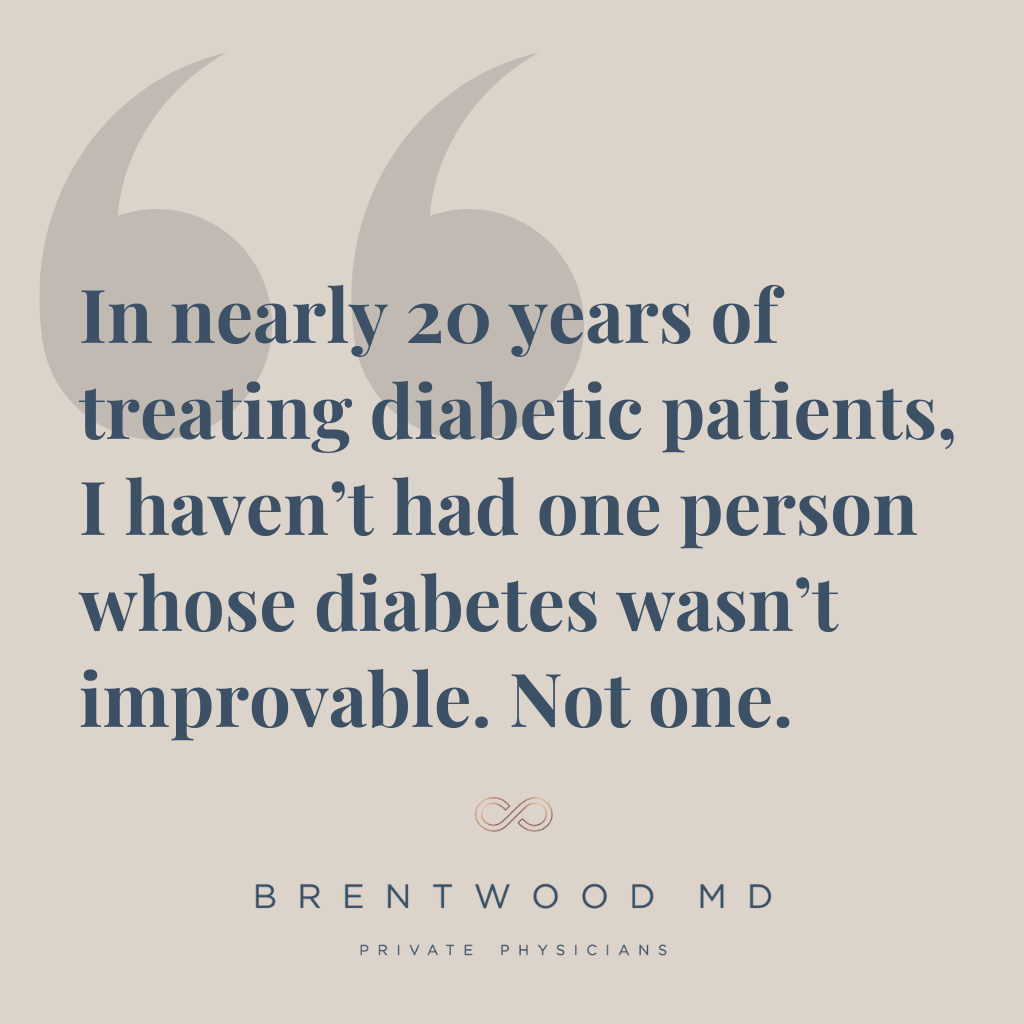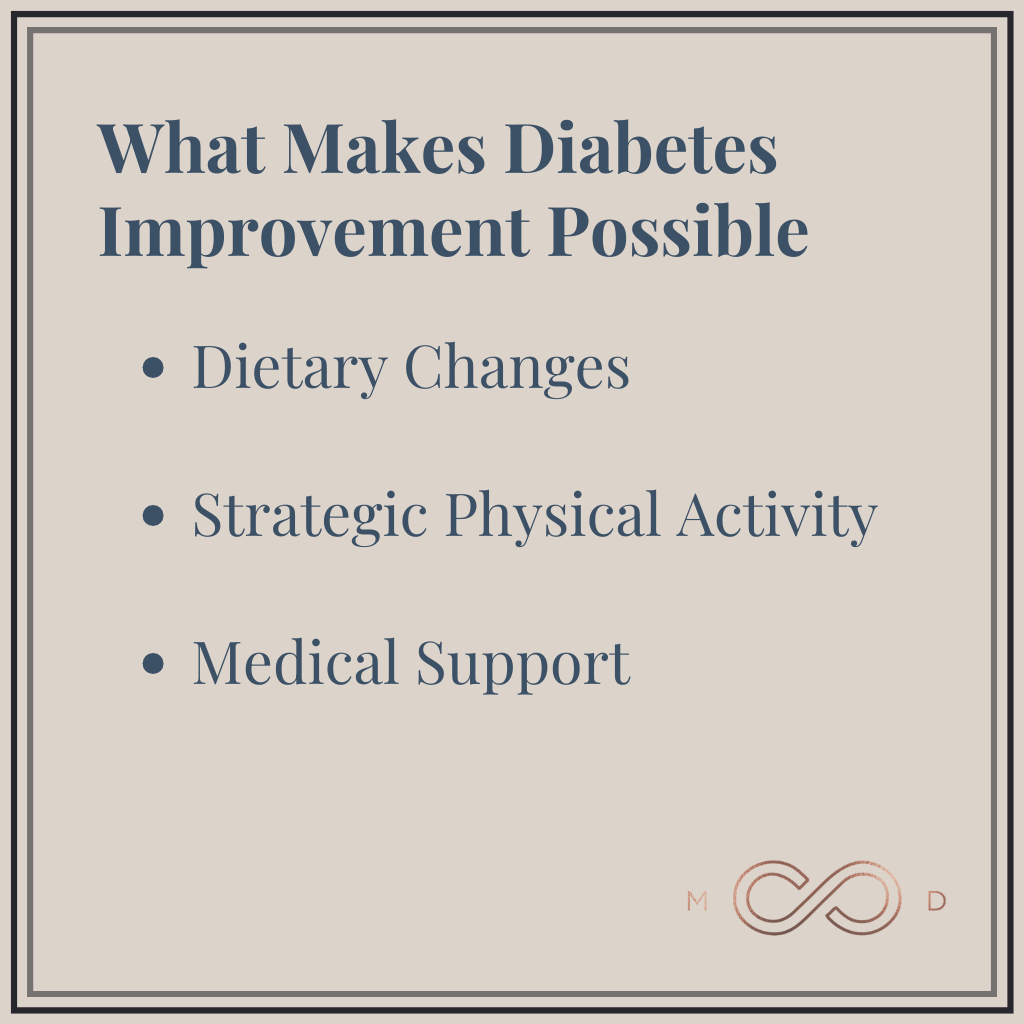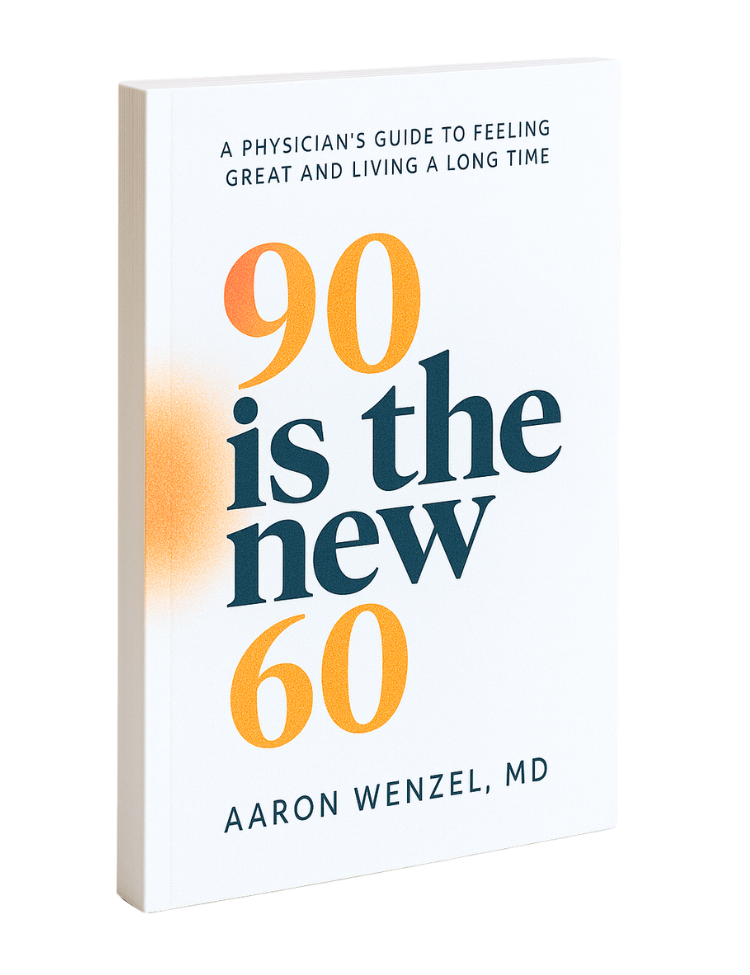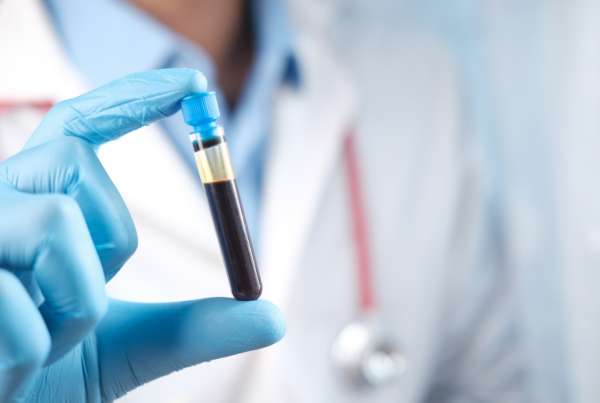Can you reverse type 2 diabetes?
This question has come up in my practice a fair amount, especially from patients in their 60s and 70s who’ve heard about diabetes reversal but worry it’s too late for them.
Here’s what I tell them: In nearly 20 years of treating diabetic patients, I haven’t had one person whose diabetes wasn’t improvable. Not one.
Let me explain what that means and why it should give you hope, regardless of where you are in your diabetes journey.
What Does “Reversing” Type 2 Diabetes Actually Mean?
Before we dive in, let’s get clear on terminology. The medical community doesn’t use the word “cured” when it comes to type 2 diabetes. Instead, they talk about remission.
Remission means your blood sugar levels return to a non-diabetic range without needing glucose-lowering medications, and you maintain this state for at least three months. It’s a significant achievement, but it requires ongoing commitment to the lifestyle changes that got you there.
The key here is that diabetes reversal is really about addressing the root cause — insulin resistance — rather than just managing symptoms.
Think of your insulin like a key that gets worn down from overuse. When you eat, your body breaks your food down into its component parts. One of those parts, especially when eating carbohydrates, is glucose (aka, sugar), which ends up in your bloodstream. This is what we mean by “blood sugar.”
Every time your blood sugar rises, your pancreas releases insulin to “unlock” your cells, allowing glucose to enter and provide energy. This clears the glucose from your blood, lowering blood sugar until you eat again.
DOWNLOAD OUR FREE EBOOK
Concierge Medicine is the future of healthcare.
Learn more about this refreshing alternative to traditional primary care, and decide if it's right for you.
Key Considerations to decide...
Is Concierge Medicine Right for You?
When you consistently eat foods that spike your blood sugar, however, your cells become less responsive to insulin’s signal over time. The “key” has trouble opening the door, and your pancreas then compensates by producing more insulin. When this process continues over years, your system becomes completely overwhelmed. The key can no longer do its job; your blood sugar stays elevated, and you’ve developed diabetes.
This is why doctors check fasting blood glucose numbers. A normal fasting blood glucose is under 100 mg/dL, meaning you have well-controlled blood sugar. Pre-diabetes starts at 100–125 mg/dL, and diabetes is diagnosed at 126 mg/dL or higher.
But here’s what most people don’t realize: Diabetes isn’t a disease you’re free from one day and suddenly have the next. It’s simply insulin resistance — which develops over months and years — finally hitting an extreme.
Even if your fasting blood sugar falls into the “normal” range, you could be developing insulin resistance if your number is trending upward over time. That’s why tracking patterns, not just numbers, is so important in catching and reversing this process early.
The Reality Check: Nearly Everyone Can Improve Type 2 Diabetes
I want to be completely honest with you. Can everyone reverse their type 2 diabetes completely? Probably not. The answer depends on several factors:
- How advanced your diabetes is
- How long you’ve had it
- What other health processes are involved
- Your available time, energy, and resources
- Your personal threshold for making significant changes
But here’s what I can tell you with confidence: If you’re committed to improving your diabetes, you’ll be able to make progress.
Some people I’ve worked with have completely reversed their diabetes despite thinking they were “too far gone.” Others have made substantial improvements that dramatically enhanced their quality of life and reduced their medication needs.
So, even if you don’t achieve complete remission, meaningful improvement is almost always possible. If you’re asking, “Can you reverse type 2 diabetes?” it’s tempting to focus only on the idea of complete reversal. But remember, better is better, and any progress makes a significant difference in your longevity and quality of life.
What Makes Diabetes Improvement Possible?
The primary driver of diabetes reversal is addressing insulin resistance, and the most effective way to do that is through weight loss. Even modest weight reduction — 5 to 10% of your body weight — can significantly improve blood sugar control.
Here are the top strategies for reversing type 2 diabetes that research and my experience say work:
Reversing Type 2 Diabetes: Dietary Changes
The foundation of diabetes reversal starts with what and when you eat.
Focus on Nutrient-Dense, Whole Foods
Simple carbs and sugars convert quickly to glucose, spiking blood sugar and necessitating release after release of insulin. Highly processed foods often fall into this category and are especially insidious because they’re so available. One helpful question for avoiding the pitfalls of modern foods (and, therefore, modern diseases) is this: Was it food 120 years ago?
If not, then it isn’t food today.
Instead, aim for whole, lean proteins like fish, chicken, and eggs to help stabilize your blood sugar while providing essential amino acids. Non-starchy vegetables should make up the bulk of your plate; they’re packed with fiber and nutrients while having minimal impact on blood glucose. And healthy fats from sources like avocados, nuts, fish, and olive oil actually help improve insulin sensitivity.
Limit Carbohydrates
Sugar and refined carbohydrates create the biggest blood sugar spikes, forcing your pancreas to work overtime. As such, moderate carb restriction often has a positive impact on weight loss and insulin resistance.
Shifting to a whole-food, protein-forward diet helps you stay full for longer and avoid the blood sugar rollercoaster, which also helps reduce your body’s cravings for easy, carb-rich snacks.
Try Intermittent Fasting
Research shows that intermittent fasting, also called time-restricted eating, is a powerful tool for reversing insulin resistance and, consequently, aiding weight loss.
By extending the periods in which you’re not eating, your bloodstream no longer experiences a constant influx of glucose. Your pancreas gets a break, and your cells get the rest they need to become more sensitive to insulin again.
To implement intermittent fasting, I suggest considering your lifestyle and starting with the change that’s easiest for you. In many cases, that’s simply eliminating breakfast. Your body may protest at first, but I’ve found that’s largely out of habit. After a week or two, your system will no longer beg for an early morning hit of dopamine-inducing sugar.
Aim for a minimum 12-hour window that includes your night’s rest, like 7 p.m. to 7 a.m. If you’re able, you might work toward a 14- or 16-hour fasting window, but not more than 24 hours. Again, take your individual biology and lifestyle into account, and work with your physician if you have any additional factors (like a recent illness) that might make fasting risky for you.
Reversing Type 2 Diabetes: Strategic Physical Activity
The only tool your body has for controlling blood sugar besides insulin is exercise. When your muscles contract during exercise, they take up any readily available glucose from your bloodstream. This is why taking a 10-minute walk after eating is such an effective way to lower blood sugar. But exercise has other benefits for reversing type 2 diabetes as well.
Start Strength Training
Muscle tissue is metabolically active and acts like a glucose sponge, helping to lower blood sugar levels even when you’re at rest. So, building muscle mass creates more glucose storage capacity in your body.
You don’t need to become a bodybuilder to reverse type 2 diabetes. Even modest gains matter, and just two to three resistance training sessions per week can make a significant difference.
Include Cardiovascular Exercise
Regular cardio improves your body’s ability to use glucose efficiently and helps with weight management. But you don’t have to run marathons to reverse type 2 diabetes. The key is finding movement you enjoy doing consistently, whether that’s walking, swimming, dancing, or hiking.
Reversing Type 2 Diabetes: Medical Support
Even using the strategies above, people sometimes need another lever to pull in the battle against insulin resistance.
Bioidentical Testosterone Replacement Therapy
As both men and women age, their hormonal environments begin to change. In men, this means a reduction in testosterone production each year starting around age 30. In women, it means a drop in testosterone production beginning in perimenopause.
Since testosterone helps the body produce and maintain lean muscle (while losing fat), its loss can significantly contribute to insulin resistance. Conversely, then, restoring a healthy level of testosterone can help your body recover its sensitivity to insulin.
GLP-1 Agonist Medications
You’ve likely heard of GLP-1 agonist drugs like Ozempic and Wegovy, which were developed for helping manage type 2 diabetes but are now being used for weight loss in the general population. The great news is that these medications have the potential to help patients not just with weight loss but also with reversing insulin resistance.
Even small amounts of weight loss can impact insulin resistance and, therefore, type 2 diabetes. With diabetes positioned to become one of the greatest global health threats over the next 20 years, these medications may be the innovation we need.
Of course, every drug comes with side effects and risks, and GLP-1 agonists won’t be right for everyone. This is why it’s so important to work with a doctor who knows you, who carefully monitors progress, and who understands the mechanics behind reversing type 2 diabetes.
Reversing Type 2 Diabetes: The Concierge Medicine Advantage
This is where the traditional healthcare model often falls short. In a typical appointment, you might get 15 minutes to discuss diabetes management or insulin resistance. That’s barely enough time to review your numbers, let alone create a comprehensive reversal strategy.
In concierge medicine, we have the time to dig deeper. We can explore:
- Your specific triggers and patterns
- Sustainable lifestyle modifications that fit your situation
- Coordinated care with specialists when needed
- Regular monitoring and adjustments in approach
- Emotional and psychological aspects of making significant health changes
By working closely with our members, we have the opportunity to create a strategic plan for potentially reversing type 2 diabetes. This plan doesn’t depend on a brief encounter and some population-based health recommendations but on each individual’s needs, numbers, symptoms, and lifestyle.
How to Get Started
If you’re reading this and thinking, “Maybe there’s hope for me too,” here’s where I’d suggest you begin:
Find your team. Work with a healthcare provider who will listen to your goals, answer your questions, and make educated recommendations for diabetes reversal or improvement.
Start with one change. Don’t try to overhaul your entire life overnight. Pick one sustainable modification, whether that’s eliminating sugary drinks or taking a 20-minute walk after dinner. Once that’s a habit, add another.
Track your progress. Monitor your blood sugar levels, weight, and how you feel. As you notice even small improvements, you’ll build momentum for bigger changes.
Be patient with yourself. Type 2 diabetes doesn’t develop overnight, and reversing it doesn’t happen overnight either. Meaningful change takes time, but every positive step is moving you in the right direction.
Can You Reverse Type 2 Diabetes? Final Thoughts
So, can you reverse type 2 diabetes? Maybe. Can you improve it? Almost certainly, if you’re committed to making changes.
The question isn’t whether you have enough runway — it’s whether you’re ready to start moving down it.
I’ve seen 70-year-olds make remarkable improvements. I’ve worked with people who thought they were beyond help to achieve outcomes they never imagined possible. The human body’s capacity for healing and adaptation is truly remarkable.
Your diabetes story doesn’t have to end with increasing medication and progressive decline. With the right strategy, support, and commitment, you might be surprised by what’s possible.
The only way to find out is to get started.

Dr. Aaron Wenzel is a concierge physician specializing in the care of fast-moving entrepreneurs, executives, and public figures in the Nashville, TN area. Dr. Wenzel’s diverse life experience and extensive training in family medicine, emergency care, nutrition, and hormone replacement therapies give him the unique platform to provide unmatched care for his patients.



